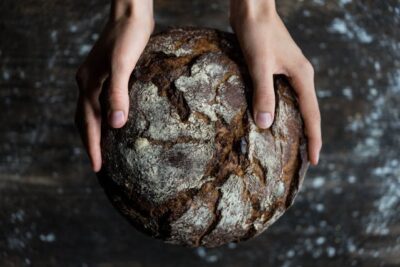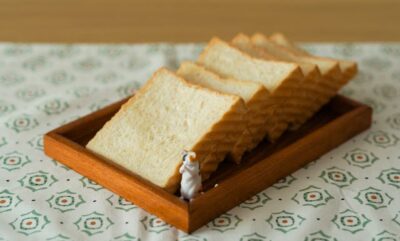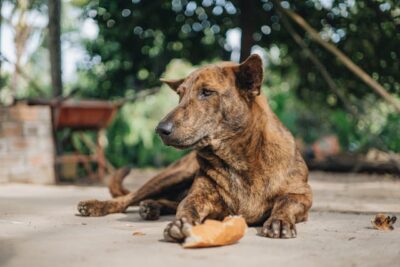Overview
Introduction to Can Dogs Eat Bread

For many of us, the smell of freshly baked bread is irresistible. Whether it’s a hearty slice of wheat bread, a tangy sourdough loaf, or a sweet treat like banana bread, bread is a staple in many households.
But what about our furry friends Can dogs safely enjoy bread, or should it be kept off their menu?
In this article, we’ll explore the topic of dogs and bread, including the risks of bread dough, the dangers of garlic bread, and the potential benefits and drawbacks of including bread in your dog’s diet. Join us as we answer the question, “Can dogs eat bread?”
Overview Of The Topic Can Dogs Eat Bread
Dogs can eat bread in moderation, but there are several important considerations. Bread dough, especially if raw, can be dangerous as it can expand in the stomach and cause bloating or even alcohol poisoning. Garlic bread should be avoided, as garlic can be toxic to dogs.
Additionally, too much bread in a dog’s diet can lead to obesity and other health issues. When offering bread to your dog, opt for plain varieties like wheat or sourdough, and avoid giving them banana bread or other sweetened types. Can dogs eat bread? Yes, but it’s crucial to be aware of these potential risks and limitations.
Bread as a Common Human Food
Bread is a common human food that dogs can eat in moderation. However, there are some important considerations. Dogs should not consume bread dough, as it can expand in their stomach and cause digestive issues.
Additionally, while plain bread like sourdough is generally safe for dogs, garlic bread should be avoided, as garlic can be toxic to them.

Nutritional Value of Bread
Basic components of bread
Bread can provide dogs with some nutrients, but it is not a necessary part of their diet. White bread, while not toxic to dogs, is low in nutritional value and high in carbohydrates, which can contribute to weight gain if fed in excess.
It’s best to offer bread to dogs as an occasional treat rather than a regular part of their diet.
Vitamins and minerals in bread
While bread contains some vitamins and minerals, such as B vitamins and iron, it is not a significant source of these nutrients for dogs.
Dogs have different nutritional requirements than humans, and their diet should primarily consist of high-quality dog food tailored to their needs. Offering bread to dogs should be done in moderation, as it is not essential for their overall health and nutritional benefits.

Can Dogs Eat Bread Safely?
Bread as non-toxic to dogs
While bread itself is generally non-toxic to dogs, it’s important to be mindful of potential harmful ingredients.
Bread containing artificial sweeteners like xylitol, or additives like garlic powder, chocolate chips, or macadamia nuts, should be avoided, as these ingredients can be toxic to dogs. When offering bread to dogs, opt for plain varieties without these potentially harmful additions.
Risks associated with bread consumption
While bread itself is not typically harmful to dogs, there are some risks associated with its consumption. Dogs may experience an upset stomach or abdominal pain if they eat too much bread. Additionally, bread dough containing yeast can expand in a dog’s stomach, causing bloating and potential alcohol toxicosis.
It’s important to avoid bread containing toxic ingredients like artificial sweeteners and to feed bread to dogs in moderation to prevent issues like kidney failure, high blood pressure, and low blood pressure.

Types of Bread Dogs Can Eat
Whole grain vs. white bread
When it comes to types of bread dogs can eat, whole grain varieties are generally safer than white bread. Whole grain breads offer more nutritional value and are less likely to contain harmful ingredients like artificial sweeteners.
White bread, while not toxic, offers little nutritional value and should be fed to dogs in moderation to avoid potential digestive issues.
Homemade vs. store-bought bread
When considering types of bread for dogs, homemade bread is often safer than store-bought varieties. Homemade bread allows for better control over ingredients, ensuring that harmful additives like macadamia nuts or chocolate chips are not included.
Store-bought breads may contain artificial sweetener or other toxic ingredients, and the rising process of bread dough can pose risks if consumed by dogs.

Benefits of Feeding Bread to Dogs
Source of carbohydrates
Bread can be a source of carbohydrates for dogs, which are an essential part of their diet and provide energy. However, it’s important to feed bread to dogs in moderation, as too much can lead to weight gain and other health issues.
Additionally, whole grain breads are a healthier option than white bread, as they contain more nutrients and fiber.
Potential benefits for digestion
Feeding bread to dogs in moderation can potentially benefit their digestion. The fiber content in whole grain breads may help regulate bowel movements and promote a healthy digestive system.
However, it’s important to note that each dog’s digestive system is unique, so it’s best to introduce bread into their diet gradually to monitor for any adverse reactions.

Risks of Feeding Bread to Dogs
Allergies and intolerances
While bread is generally safe for dogs to eat, it can pose risks for those with allergies or intolerances. Dogs can be allergic to ingredients commonly found in bread, such as wheat.
Additionally, bread containing garlic should be avoided, as it can be toxic to dogs and may cause damage to red blood cells. Feeding bread as a filler food to dogs with wheat allergies or sensitivities can lead to digestive issues like upset stomach or diarrhea.
Obesity and weight gain
Feeding bread to dogs can contribute to obesity and weight gain if not given in moderation. White bread, in particular, is high in carbohydrates and low in nutritional value, making it a less ideal choice for dogs.
It’s important to monitor how much bread you feed your dog and ensure it’s part of a balanced diet to prevent weight-related health issues.

Bread as a Treat for Dogs
Occasional vs. regular consumption
Bread can be given to dogs as an occasional treat, but it should not be a regular part of their diet. While dogs can eat white bread in moderation, it is not a necessary or nutritious food for them.
It’s important to feed your dog a balanced diet tailored to their specific nutritional needs and limit the amount of bread given as a treat.
Moderation in feeding bread to dogs
While bread can be a treat for dogs, it should be fed in moderation. Too much bread can lead to digestive issues and contribute to obesity. When offering bread to your dog, it’s important to consider it as an occasional indulgence rather than a regular part of their diet.

Bread and Common Health Issues in Dogs
Impact of bread on diabetic dogs
Bread can pose challenges for diabetic dogs due to its high carbohydrate content, which can cause spikes in blood sugar levels. Additionally, dogs with a wheat allergy should avoid bread, as it can trigger allergic reactions.
It’s important for owners of diabetic or allergic dogs to carefully monitor their pet’s diet and consult with a veterinarian for suitable alternatives.
Effect on dogs with gluten sensitivity
Dogs with gluten sensitivity or a wheat allergy may experience digestive issues if they eat bread containing wheat. Symptoms can include upset stomach, diarrhea, and skin irritations.
Owners need to be aware of their dog’s dietary sensitivities and choose bread alternatives that are safe for them to consume.

How to Feed Bread to Dogs Safely
Precautions when feeding bread to dogs
When feeding bread to dogs, it’s important to take precautions to ensure their safety. Avoid giving them bread dough, as it can expand in their stomach and cause discomfort.
Additionally, monitor their intake to prevent overeating, which can lead to digestive issues. Choose plain bread without any harmful ingredients, and feed it to them in moderation as a treat.
Monitoring for any adverse reactions
When feeding bread to dogs, it’s important to monitor them for any adverse reactions. Watch for signs of stomach upset, such as vomiting or diarrhea, especially if they’ve consumed raw dough.
If your dog shows any signs of discomfort after eating bread, consult your vet immediately for guidance.

Alternatives to Bread for Dogs
Healthier snack options for dogs
There are several healthier snack options for dogs that can serve as alternatives to bread. Fresh fruits like apples or bananas, and vegetables like carrots, celery, or cucumber, are safe and nutritious choices.
Additionally, lean meats such as chicken or turkey can be given to dogs as a protein-rich treat. These alternatives can provide variety in their diet while ensuring they receive the necessary nutrients.
Homemade treats without bread
Homemade treats can be a great alternative to bread for dogs. You can make treats using ingredients like peanut butter, oats, and pumpkin, which are safe and nutritious for dogs.
These homemade options allow you to control the ingredients and ensure they are free from harmful additives found in some store-bought treats.

Bread Recipes for Dogs
Homemade bread recipes for dogs
Making homemade bread for dogs can be a fun and rewarding experience. You can try recipes that use dog-friendly ingredients like whole wheat flour, oats, and peanut butter.
Just be sure to avoid adding any harmful ingredients like xylitol or raisins, and monitor the dough’s rising process to ensure it doesn’t become a choking hazard for your furry friend.
Bread-based treats for dogs
There are many bread-based treat recipes that can be safely made for dogs. Using dog-friendly ingredients like whole wheat flour, oats, and mashed sweet potatoes, you can create tasty and nutritious treats.
It’s important to avoid ingredients like xylitol and raisins, which can be harmful to dogs, and to monitor the rising of the dough to ensure it’s safe for consumption.
Conclusion to Can Dogs Eat Bread
Recap of key points to Can Dogs Eat Bread
- Bread can be given to dogs as an occasional treat, but it should not be a regular part of their diet.
- When offering bread to dogs, it’s important to choose plain varieties without harmful ingredients like garlic or artificial sweeteners.
- Bread should be fed to dogs in moderation to prevent obesity and digestive issues.
- Dogs with allergies or sensitivities should avoid bread containing wheat or other allergenic ingredients.
Summary of whether can dogs eat bread and under what circumstances
While dogs can eat bread in moderation, it’s important to be cautious about the type of bread and the ingredients used. Plain, whole grain breads are generally safe for dogs, but bread dough and bread with harmful additives should be avoided. Can dogs eat bread? Yes, but it’s crucial to choose wisely.
Bread should never replace a balanced diet tailored to a dog’s specific nutritional needs. It’s best to consult with a veterinarian before introducing bread or any new food into your dog’s diet to ensure it is safe for them.
Explore our delightful selection of puppies for sale in Georgia, thoughtfully bred and raised with love from reputable breeders. Each furry friend is guaranteed to meet your expectations, becoming a cherished addition to your family.
Frequently Asked Questions (FAQs) About Can Dogs Eat Bread
- Can dogs eat bread?
- Yes, dogs can eat bread in moderation. Plain, whole grain bread is generally safe for dogs, but it should not replace a balanced diet.
- Can dogs eat garlic bread?
- No, garlic is toxic to dogs and should be avoided. Garlic bread can be harmful to their health.
- Is sourdough bread safe for dogs?
- Sourdough bread is generally safe for dogs to eat in moderation, but it’s best to avoid giving them bread with any harmful additives.
- Can dogs eat wheat bread?
- Yes, dogs can eat wheat bread in moderation, but some dogs may have wheat or grain allergies, so it’s important to monitor their reaction.
- Is banana bread safe for dogs?
- Dogs can eat banana bread in small amounts, but it should not contain any ingredients that are harmful to dogs, such as raisins or chocolate.
- Is raw bread dough safe for dogs?
- No, raw bread dough can expand in a dog’s stomach, leading to bloating and discomfort. It can also ferment, causing alcohol poisoning.
- Can dogs eat rye bread?
- Plain rye bread in small amounts is generally safe for dogs, but it’s important to monitor their reaction, especially if they have a grain allergy.
- Is plain white bread safe for dogs?
- Plain white bread is safe for dogs to eat in moderation, but it offers little nutritional value and should not be a staple in their diet.
- Can dogs eat brown bread?
- Brown bread is safe for dogs to eat in moderation, but it’s important to choose varieties without harmful additives.
- What should I do if my dog snatches bread?
- If your dog snatches bread or any other food, monitor them for any adverse reactions and contact your veterinarian if you notice any symptoms of discomfort or illness.
- Can dogs eat sourdough bread?
- Dogs can eat sourdough bread in small amounts, but it should not be a regular part of their diet.
- Can dogs eat bread if they have a wheat or grain allergy?
- If a dog has a wheat or grain allergy, it is best to avoid feeding them bread or any other foods containing wheat or grains.
- Can dogs eat raisin bread?
- No, dogs should not eat raisin bread or any other foods containing raisins, as raisins can be toxic to dogs.
- Can dogs eat whole wheat bread?
- Dogs can eat whole wheat bread in moderation, but some dogs may have sensitivities or allergies to wheat




